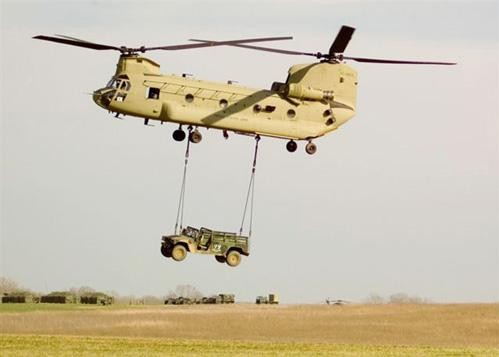|
OTC tests new
horizons for military aviation
By Kelly Patrice
Pate, OTC PAO
This
may not be your father’s era in aviation, but he would
be proud.
Two test teams from the West Fort Hood-based U.S. Army
Operational Test Command traveled to Fort Campbell, Ky.,
and to Barstow, Calif., to test the wings of two new
military birds this spring.
At Fort Campbell, the test team linked up with local
pilots to perform more than 60 hours of flight tests on
the Army’s new F model Chinook, the CH-47F, a helicopter
recognizable by its long fuselage and two rotors.
Chinooks are used to transport cargo and troops
in-theater, and until now, have relied on hand-held maps
and a panel of analog gauges to do so.
CWO 4 Tom Miskowiec, a pilot with B. Co.,
7th Battalion, 101st Airborne Division, who flew the
older D model Chinook in Iraq in 2005, said the upgrade
in the cockpit from analog to digital — namely, the new multifunctional display computer screens with tactical
Internet capability — have changed everything.
multifunctional display computer screens with tactical
Internet capability — have changed everything.
“It was like giving a kid a computer that had never had
one,” Miskowiec said.
The new onboard equipment with moving
maps and satellite imagery coordinates with a tracking
system on the ground.
“You can literally look at a satellite photo of where
you are over the ground and where you need to go in
relation to the flight plan,” Miskowiec said.
A squall of blinding dust contrasted with
the storm cell on the horizon in western Kentucky as the
tan colored Chinook Miskowiec piloted lifted off the
ground.
It was a test flight after engine maintenance, and
members of the test team looked on as the massive blades
of the Chinook, each weighing more than 300 pounds,
slammed the air.
Avengers, which provide mobile short-range missile
protection systems mounted onto humvees were in place
nearby to test whether a programmed signal from the
aircraft would be read as friend, foe or unknown.
The mission for later in the evening was
to transport a humvee to a remote location using
night-vision goggles.
Though the temperature was warm outside, a data
collector standing by to board the aircraft wore an
extra long-sleeved shirt underneath his flight suit; the
temperature inside the Chinook would drop noticeably on
the night mission.
Tents buzzed with briefings as crews made
up of Soldiers, civilians and contractors scurried from
test site to the remote drop zone to chart progress.
Miskowiec explained that thanks to the digital age, the
crew inside the F model is more situationally aware.
They determine from the display units the positions of
other players on the battlefield, including ground force
units, other air elements, geographical elements and
infrastructures, such as hospitals, from which they can
get support.
Miskowiec was with the test from its beginning phase
when the flat panel display first became functional.
Whether it’s moving external or internal loads, mass
casualties or combat assaults, every mission is about
people, he said.
“We always kept that in the forefront
that there’s a people element to what we’re doing. When
we move those critical items, those are people who are
more comfortable, more able to do their missions without
having to get in a truck and face an IED. Less people
are at risk,” Miskowiec said.
In the high desert of California, another
OTC test team rehearsed in advance of the test mission.
Lines of tape and string mapped out the scenario on the
floor with aerial photos of landmarks enroute to the
remote site.
Their mission would involve lifting a container using
the “new Huey” — the UH-72A Lakota. The question was how
this helicopter, known to the civilian world as the
EC-145 (EuroCopter), translates into military terms for
medical evacuation and transport missions.
For medical evacuation purposes, the
Lakota accommodates two litters arranged side by side
and is equipped with a side-mounted hoist apparatus.
The Lakota can also be used to carry six passengers.
CWO 4 Michael Chaiko, a standardization instructor pilot
with the New Jersey National Guard, said he welcomes the
light utility helicopter to the ranks.
“This is a fantastic helicopter compared
to what I’m used to flying, a 35-year-old legacy
aircraft from Vietnam, the OH 58 A-C. This has really a
lot more power, a lot more versatility. I’m doing things
I’ve never done before because I haven’t had the
capability of the hoist and the sling. With the
helicopter I’ve been flying for the last 12 years, we’re
lucky if we can get three people off the ground,” Chaiko
said.
One of its advantages is its ability to
hover.
“This aircraft has a unique rotor system that is very
responsive. The technology allows you to actually take
your feet off the pedals. It will provide you
directional control; it flies better than the pilot in a
lot of cases,” Chaiko said.
Crew chief Spc. Donald Williams, whose
job is to control loading and unloading of patients and
cargo, said he is required to be hoisted up and down the
hoist cable so he understands his role from his team
member’s (flight medic) perspective.
The Army’s acquisition of this aircraft
would free up Black Hawk helicopters for use in Iraq and
Afghanistan. The intent is for the Lakota to aid in
homeland security, disaster relief and law enforcement
support, including drug stings.
“It’s taking a civilian off-the-shelf product and trying
to tailor it to the Army’s needs,” Williams said. “It’s
exciting to be part of something new and see where it
goes.” |